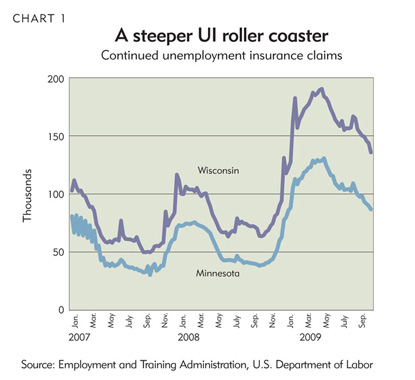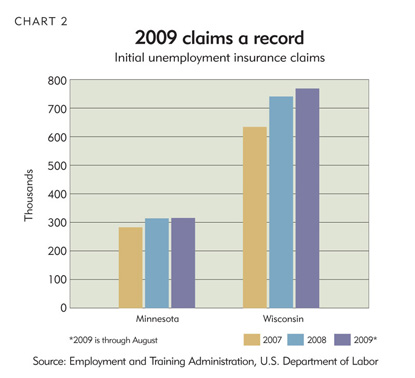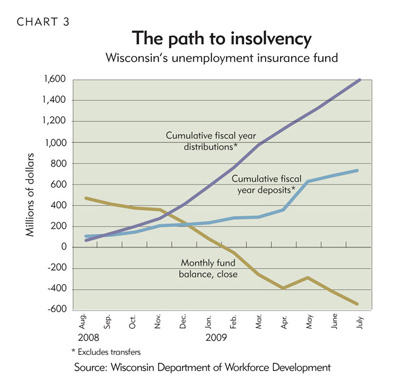
In the next couple of years, the longest, deepest slide in the job market in a generation will force states to borrow billions of dollars across much of the Ninth Federal Reserve District.
The scramble for more money is the latest chapter in the employment compact between states and workers that dates to the Great Depression. When workers lose their jobs through no fault of their own, employer-financed unemployment insurance (UI) helps pay the bills during the search for work.
But as the ranks of the jobless—and the time spent looking for work—have swelled, the funds that pay UI benefits are scraping bottom in many states, including those in the Ninth District. When this happens, states must borrow from the federal government to keep paying benefits—Minnesota and South Dakota have already done so, and Wisconsin is not far behind. As part of the deal, states are required to offer more generous benefits—a politically popular move with financial consequences that states have only begun to tally.
Replenishing depleted UI trust funds and repaying loans from the federal government will take years. The problem will threaten to push state legislatures to raise UI premiums for employers, reduce jobless benefits or both. Either way, the moves will have real, if hard-to-measure, consequences for job growth and incomes in the region.
Check, please
UI benefits routinely extend for only 26 weeks, on the theory that six months is plenty of time for a displaced worker to seek and find a new job. But this recession has challenged both workers and the UI programs designed to help them through a rough spot. Jobless claims are much higher, workers are staying on UI much longer and UI funds are getting depleted (more on each of these trends in a bit).
So earlier this year, as part of the Obama administration’s economic stimulus plan, Congress approved extensions and supplemental benefits that required states to make more of the jobless eligible for UI, and for a longer period.
For instance, Minnesota in the spring received $130 million in federal dollars to boost the state’s UI fund. Meanwhile, federal emergency unemployment compensation benefits are set to provide an additional $390 million in benefits in Minnesota through the end of the year—a cost being picked up by the federal government via the stimulus bill. State and federal governments have split the tab in the past.
With added federal dollars, states can pay up to 79 weeks of unemployment checks. In addition, Congress has provided a federal supplement of $25 per claim per week to state UI programs.
The millions and billions in jobless benefits, paid out by states small and large, absorb shocks that would make an economic reversal all the more painful in their absence. “People take those benefits and put them right back into the economy. Normally, the money is spent on food, shelter and the mortgage,” said Roy Mulvaney, Montana’s UI administrator. “Those benefits are helping sustain a lot of the businesses that are out there.”
Under the UI hood
State UI funds are financed by employer-paid taxes. Each state is free to set the UI tax rate and how much of an employee’s pay is subject to the tax.
In 2009, Minnesota employers subject to the UI tax pay on gross wages up to $26,000. The rates vary, based on whether employers have a history of layoffs. A new employer, in an industry where job cuts are rare, pays a tax of about 2.3 percent on the taxable wage base. In Wisconsin, only the first $12,000 is subject to IU taxes, which top out at 3.4 percent for new employers.
Rates for more established employers can go much higher—up to 9.3 percent in Minnesota. But these rates are harder to compare because layoff histories play a different role in determining rates in each state.
Disparities among states also exist for UI benefits. In Minnesota, standard weekly UI benefits are capped at $566—about $200 more than in Wisconsin. Only about one in eight workers in Minnesota qualifies for the top benefit, which is based on pay and work history. Still, it was enough to pull the average weekly UI benefit in Minnesota last July to $363—27 percent higher than in Wisconsin.
With this UI architecture of costs and benefits in place, rumbles in the labor market have shaken UI funds across the Ninth District.
At the close of November 2007, the last month before the start of the current recession, Minnesota paid 38,465 continuing claims, a figure that rose to more than 131,000 by April 2009 (see Chart 1). By early August, it had come down to about 98,000. South Dakota claims and their benefits reached “unprecedented” levels, according to Don Kattke, director of South Dakota’s UI division. Claims were just 1,400 in November 2007, but spiked to more than 8,000 last April before pulling back to about 5,400 by early August.
Compounding the problem for UI funds is that the jobless are receiving UI benefits for longer periods. So far this year, the average duration of unemployment in Minnesota swelled to near 22 weeks, up from 18 weeks last year and 14 weeks in 2007.
More are also breaching the previous UI benefits standard of 26 weeks. At the end of July, more than 13,300 Minnesotans had done so—a huge increase from the 5,200 in July of last year. So-called final payments more than tripled in Wisconsin, North Dakota and Montana from July 2008 to July 2009. Among district states, only in Michigan, where final claims for standard benefits have remained elevated for years—a measure of the state’s persistent high unemployment rate—did final claims drop slightly over the same period.
Breaking the piggy bank
Although continuing claims have moderated of late, the elevated number of jobless claims and elongated duration of claims means UI funds in many states are hitting bottom, or will be soon, because states are paying out far more in claims than they are taking in from UI premiums.
In July, for example, the Minnesota UI fund paid out more than $1.3 billion in benefits, but took in $900 million in deposits. Wisconsin’s UI fund is unraveling even more quickly. It paid nearly $1.7 million in UI benefits in July, more than double the $733,000 in deposits, as the state has been battered particularly hard by the current recession. Initial UI claims this year through the end of August came to 773,000—far higher than the 317,000 in Minnesota during the same period (see Chart 2).
Why would Wisconsin, a state with about the same population as Minnesota, record towering UI claims? Officials in both states pointed to industry mix (e.g., more manufacturing in Wisconsin) and higher claims in hard-hit industries (like manufacturing), along with a higher propensity in Wisconsin for filing UI claims, which is partly due to broader eligibility for initial claims there.
The good news for UI programs is that continuing claims are declining. In July, Minnesota’s unemployment rate declined to 8.1 percent, after the state added 10,300 jobs. But this was the first job gain in 11 months, while the number of continuing claims peaked several months earlier. So it’s unclear whether the easing of claims is the result of the jobless exhausting benefits or finding enough work to no longer qualify for checks. Complicating matters is the fact that forecasters—including those at the Federal Reserve Bank of Minneapolis—are expecting slow job growth into 2010, so UI rolls are unlikely to decline quickly, especially given newly extended benefits.
In the short run, UI payments counterbalance some of the financial travails of layoffs numbering in the millions nationwide and the hundreds of thousands across the Ninth District. That’s doing the job Congress intended when jobless insurance programs were introduced three quarters of a century ago.
But burdens on UI coffers are likely to continue across the district, and despite the stimulus money, many states have to borrow additional funds from the federal government to continue paying claims. For the first time ever, South Dakota expects to borrow $6.7 million from the federal government this year, and $91 million next year, to pay jobless claims, according to Kattke.
Wisconsin expects to take out $1 billion in federal fund loans to make up for 2009 state UI fund deficits (see Chart 3). More likely will be needed next year, although Wisconsin officials haven’t yet offered estimates. In the aftermath of the 2001 recession, Wisconsin avoided federal borrowing to keep its UI fund solvent.
Minnesota projects the state’s current UI shortfall will require $1.8 billion in federal borrowing—a debt that could take years to repay.
Only North Dakota and Montana expect to avoid borrowing to pay unemployment benefits this year and next. North Dakota can thank oil and gas drilling, in part, for avoiding the fate of many of its neighbors. Montana, without a big share of jobs in manufacturing and construction—two industries hard hit in the downturn—also expects to emerge with its UI fund intact (see Chart 4).
“These last few years, we’ve had record-low benefit payments,” said Darren Brostrom director of North Dakota’s UI Job Service. “The (slumping) economy hit us when we were in a very good position. … We had enough money to weather any additional benefits that we had to pay.”
Free kitten, anyone?
Going forward, states are faced with the prospect of replenishing their own UI funds while repaying federal loans. For some, this will not be daunting. By the second half of next year, South Dakota UI officials expect to pay off nearly $16 million in federal liabilities.
States like Minnesota and Wisconsin won’t be as fortunate. In the aftermath of the 2001 recession, Minnesota borrowed more than $400 million to keep the state UI fund solvent. Repayment of federal loans stretched into 2005.
“If it took two or three years last time, I presume it will take far longer this time,” said John Berglund, Minnesota’s UI financing specialist.
Lee Nelson, chief attorney for the Minnesota Department of Employment and Economic Development (DEED), said projections made last spring soon will be revised, probably upward. But as of the end of August, he said the agency UI fund projections were daunting: “We’re going to be carrying a $1 billion deficit balance for at least three years.”
Exactly how federal loans will be repaid remains an open question in Minnesota and Wisconsin. Minnesota officials so far have identified no fewer than 17 strategies for raising revenues without changing the fundamentals of the UI system.
Businesses feel the UI pain
Almost regardless of how states choose to deal with these fiscal issues, the breaking of UI piggy banks, federal borrowing and changes to UI benefits as a condition of federal help will have a lingering effect on businesses and their hiring decisions for some time.
UI tax rates, for example, are likely headed north, particularly for those that have laid off workers, thanks to the way UI rates are set in many states: The companies that shed the most workers in hard times pay higher premiums in good times—what’s known in the industry as the experience rating. For example, since the tapped-out Minnesota UI fund soon will be supplemented by big federal loans, employers across the state will see higher premiums in the years ahead even if their payrolls remain stable. But the use of experience ratings means that UI tax rates and resulting premiums will be higher still—possibly significantly—for companies that have shed workers.
As a solution to refilling UI coffers and repaying federal loans, states are also considering changes to existing formulas that dictate how much employers pay in UI premiums. For example, the experience rating might be widened or otherwise changed to alter how employers share UI costs.
Another option is to lift the ceiling on the amount of pay subject to taxation. Minnesota taxes only the first $26,000. Wisconsin taxes the first $12,000; Michigan, $9,000; North Dakota, $23,700; South Dakota, $9,500 and Montana, $25,100.
Or states can do as South Dakota did earlier this year to quickly address its UI underfunding: It imposed a special assessment of $150 per employee to shore up the state’s UI fund. The special charge, amounting to $36 million, was added to the $26 million South Dakota also expects to collect in routine employer payments this year.
Yet another maneuver, likely to be popular in an election year, would be to let the federal government raise its UI levy temporarily to help states repay their loans. Currently, if a state is slow in repaying a UI trust fund debt, the federal government temporarily can add to the annual $56 levy per employee that firms pay when a state trust fund is in the black.
What role higher premiums will play in future hiring decisions is tough to predict. Higher employment costs would suggest reduced hiring, but not right away, because higher rates are phased in. Minnesota’s premium formula takes into account four years of payroll history. Layoffs in 2009 won’t be reflected in premiums until 2012 or later.
Another outcome of higher UI premiums, particularly in a slack job market, would be a dampening effect on wages, as employers merely pass the cost of higher UI premiums along to workers in the form of lower wages. “It might not be dampening hiring if we assumed all of the costs are not imposed on employers,” said John Budd, a professor of human resources at the University of Minnesota’s Carlson School of Management. “Essentially, workers are bearing the cost of their own insurance.”
To a large Minnesota company paying wages far above the $26,000 taxable wage base, a premium increase of several hundred dollars probably won’t be a key element in choosing whether to add workers. For an employer with lower-paid workers in seasonal industries, from landscaping to construction, the cost could be more noteworthy, however.
“Is [a UI premium increase] the straw that breaks the camel’s back? The answer almost always is no,” Berglund said. “Our impact on corporate taxes is not significant.”
Although the current recession is no run-of-the-mill downturn, past increases in UI premiums have not wrecked post-recession job recoveries. For example, after the recessions of the early 1980s, with job losses comparable to the latest downturn, Minnesota and other states shored up their UI funds with a host of changes. In the end, employers wound up paying more to guard against future shortfalls, and Minnesota nonetheless outperformed the nation in job growth over the next two decades.
But how businesses react this time around is anyone’s guess. Ultimately, it will depend on how long the downturn lasts, and the strength of any ensuing recovery. The outlook keeps changing, almost week to week.
In mid-August, Minnesota estimated that the state’s UI fund shortfall would peak at $2 billion. But by the end of the month, a sunnier economic job market prediction by the forecasting firm Global Insight prodded DEED to lower its expected peak debt to $1.8 billion.
“Let’s hope the next recession is far, far away,” said Nelson, at DEED.









